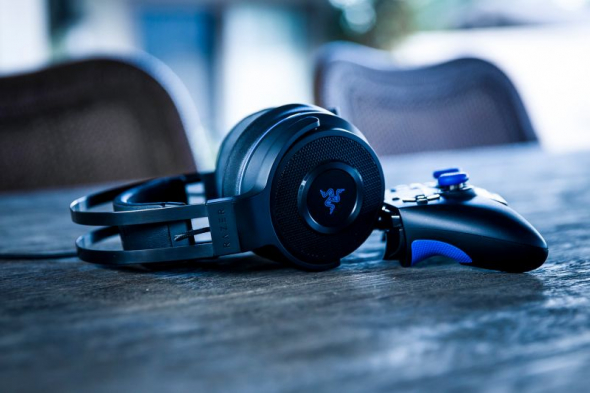Razer Thresher Ultimate Headset for PS4
I’ve been gaming for a long time, and when the rise of online gaming took hold of the industry I found myself investing more and more into internet and gaming headsets in order to have the best-sounding gaming experiences and clear communication with my friends, teams, and even enemies. Thanks to a number of different factors – such as comfort, sound quality, price, and battery life – it’s always a difficult task of finding that one perfect headset, especially when you dive into the premium side of things. Having to justify parting ways with a bit of extra cash all for a more immersive gaming experience isn’t always the easiest thing. Back during E3 2017, I got to check out a new option from a company that has done well for itself in the PC market and is seeking to bottle lightning once again on the console side of things. The Razer Thresher Ultimate headset proved to be quite comfortable with great sound, but those were my impressions after only 30 minutes or so. I couldn’t really give my full opinion without testing them out in my home setting, with sounds going off around me and a multitude of games to choose from. Fortunately enough, I had the ability to do just that recently, and I am still quite impressed with what the Razer Thresher Ultimate headset offers.
First, let’s talk about comfort. Almost anything can be comfortable for 30 minutes if you wear it just right, so I had to put this headset to the test. Long gaming sessions in the likes of The Elder Scrolls Online and Destiny aren’t anything new to me, so I wanted to make sure these were up to the task, and they were. The softer memory foam did a good job of cushioning my ear without that crushing sensation that tends to seep in after about an hour or two. Five hours in and I was just starting to feel a need to adjust the Razer Thresher Ultimate headset, and that’s not too shabby a time. The fact that players should definitely be taking breaks well before that five-hour mark during any session should prevent any discomfort, but it’s great that Razer went above and beyond to make sure that those of us who don’t necessarily follow all rules won’t pay with our ears. The weight of the headset wasn’t overbearing either, coming in at just under a pound. The leather strap, which provides a second level of support, helps to evenly distribute the weight and prevent that squeezing of your head that can sometimes happen. Also, the swiveling ear cushions, which are becoming the standard on most premium headsets, offer relief whenever you want to wear the headset around your neck during a break.

As far as sound goes, the Razer Thresher Ultimate headset does deliver. The ear cushions provide a high degree of noise isolation, something I wasn’t able to fully test out at E3. At home, though, I was able to block out the outside world as I dove into Morrowind, raced through the streets of Los Santos, or got my ass handed to me in Tekken 7. That isolation is just a fraction of the sound experience though. What matters is how clear everything sounds, how booming the bass is, whether or not you can pick up subtle noises in the background, and how surround sound ups the ante during RPGs and action-adventure experiences. Thankfully, the headset ticks all of those boxes.
In order to really test the audio quality, I dove into several different titles that offered generally different types of music and action. This was to test out the sound on the Razer Thresher Ultimate headset overall, as well as to mess around with the surround sound support. My list of games was:
- The Elder Scrolls Online: Morrowind
- Destiny
- Tekken 7
- Injustice 2
- Call of Duty: Black Ops III
The fighting games had that crisp, clear element to them which was appreciated, but it was the RPGs and shooters that really showed off the headset’s capabilities. I activated the 7.1 Dolby Surround Sound for all of them, which is done by simply clicking the small button on the audio hub packed in with the headset. In Morrowind, you could clearly make out the sounds of birds and bugs flitting about while the musical score swelled in the background and enemies attacked from all directions. Black Ops III and Destiny provided a deep, rich bass as explosions went off around me. Distinct gunfire sounded off from all angles as I navigated treacherous battlefields.
For all the great sound that the Razer Thresher Ultimate headset offered, I was left wanting in one particular area: customization. Razer is known for giving its fans control over features ranging from light colors to macro keys on its keyboard range. It would have been nice to see some type of sound profile integration that lets players create different setups for specific titles. While the sound quality is as crystal clear as promised with a sizable audio bandwidth (boasted as the highest currently available on console), what you get out of the box is what you get, period. It’s understandable that this is their first official console headset, but that extra layer of control that the company is known for would’ve definitely helped relieve some of the pressure of the premium price of $249.99.
One aspect I’ll definitely give Razer credit for in lieu of the customization is the simplicity of it all. There aren’t too many switches to deal with on the audio hub, simply a power button, a surround sound button, and a switch on the back that lets you choose whether to use the Thresher Ultimate headset on PS4 or PC (the Xbox One version is also compatible with PC). I also appreciate that the hub comes with an extra USB slot so I don’t have to hog up the front of my PS4 (which is dedicated to a controller and my PSVR headset). All volume controls are found directly on the headset itself, allowing you to raise and lower mic and game audio, or mute either one independently. The mic is retractable and glows red to let you know if it’s muted or not (which is easily seen through your peripheral vision), and does a great job at only picking up the player’s voice, no weird ambient noises or odd mechanical hums here. To help deal with head turning and range, the Thresher Ultimate headset uses dual antenna to prevent the dropping of sound as you move and a range of 20m with direct line of sight; longer than most need, but you never know. Charging is also a breeze since the headset comes packed with a long, sturdy USB cable, allowing you to play as it charges (if you’re close enough to your setup).
The battery life is certainly impressive as well. Razer boasted approximately 16 hours, so I had to put that to the test. Mine actually lasted a bit longer, though the alert that your battery is dying is a bit on the annoying side. The headset starts to give two very loud beeps every 10 seconds during the final 1-2 hours of battery time (mine lasted for around an hour and a half). They are very loud, but I still had plenty of game time to go. On the one hand, I like that they don’t just turn off without warning (which has happened to me with headsets in the past), but there is such a thing as too much warning. Still, for a quick charge of only 4 hours (I charged mine at night when no games were being played), you get a solid few sessions of gaming with no drop in quality.
All in all, the Razer Thresher Ultimate headset is a worthwhile piece of equipment. They’re quite simple to set up and use and offer the level of quality, both in comfort and sound, that you’d expect from a premium headset. Battery warning aside, my only true gripe is the lack of sound profiles, something that I thought Razer would certainly bring into the fold, and something I hope makes an appearance in the future. For now, though, this new headset is a perfect addition to the company’s lineup of console accessories. They’re easily one of the most comfortable headsets I’ve had the pleasure of wearing, and the sound quality was indeed superb. The price tag of $250 is well within the range of what you can normally expect to pay for such quality, so if you’re in the market for something a bit more substantial, I’d definitely recommend these as a more than viable option.






Published: Jun 26, 2017 11:45 am